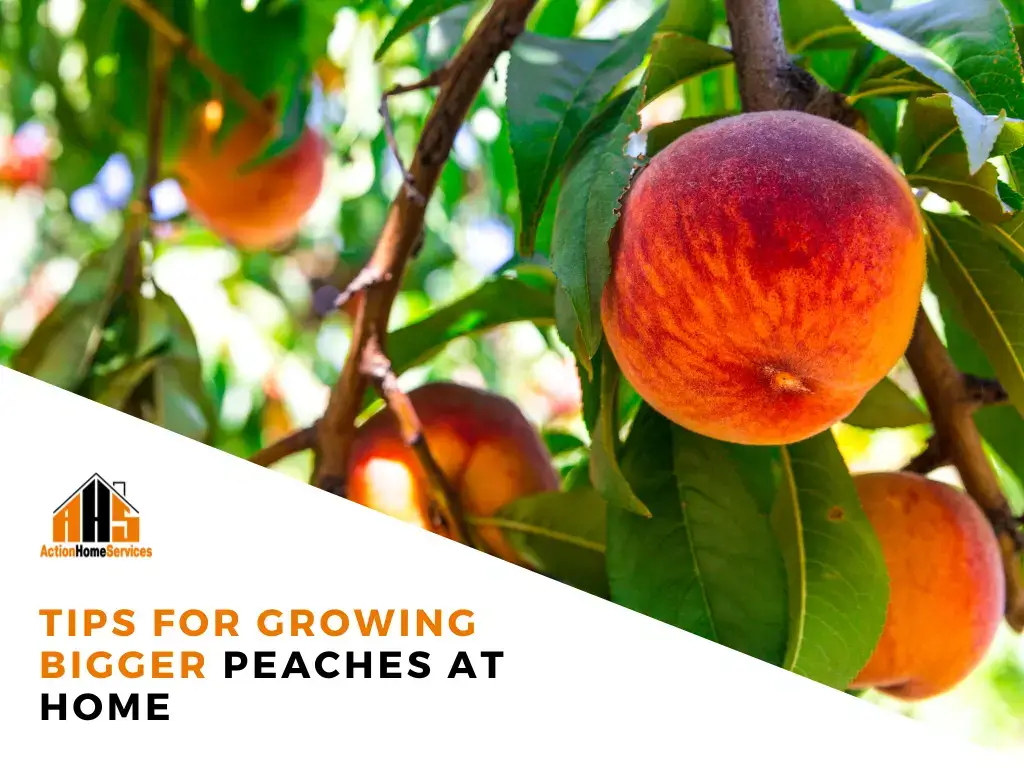
Expert advice from the horticultural team at Action Home Services
Want bigger, juicier peaches from your backyard tree? This expert guide from Action Home Services walks homeowners through the science and art of growing large, high-quality peaches in Ontario. From choosing the right variety and understanding fruit growth stages to mastering irrigation, thinning, pruning, and fertilization, we explain every step in practical detail. Whether you’re planting a new tree or trying to boost yields from an existing one, these proven strategies will help you grow peaches that truly stand out in size, flavour, and beauty.
Think this all looks a little overwhelming? Give us a call today for luxury horticultural services that will put the peach in peachy!
Table Of Contents:
1. Peach Fruit Growth Stages
2. Which Peach Tree Will Produce The Biggest Fruits?
3. Watering Schedule & Recommendations For Larger Peaches
4. Pruning Techniques For Bigger Peaches
5. Thinning Your Peach Tree Is Essential For Larger Fruit
6. Recommended Peach Tree Fertilizer and Minerals
7. How To Plant Your Peach Trees To Encourage Growth
8. Best Peach Trees for Ontario
10. Peach & Nectarine Growing at Home
1. Peach Fruit Growth Stages
To grow larger peaches, you need to understand how they develop. Peach fruit grows in three distinct stages:
- Stage I (0–50 days after bloom): This is the period of cell division, where the number of cells in each fruit is determined. Bigger peaches start with more cells. During this phase, the fruit is small but rapidly forming an internal structure. This stage is the most critical window to influence final fruit size, so early interventions matter most here.
- Stage II (Pit hardening): Growth temporarily slows while the stone (pit) hardens. Carbohydrates produced by the tree are redirected to vegetative growth, such as shoots and leaves, rather than to the fruit. Thinning should be completed by the beginning of this stage, and irrigation should be minimized to avoid diluting sugar levels and over-stimulating vegetative growth.
- Stage III (Final swell, last 4–6 weeks before harvest): This stage is characterized by rapid fruit enlargement through cell expansion. Sugar accumulation and water uptake are essential here. Fruit doubles in size during this period and final quality characteristics (taste, aroma, texture) develop.
How to influence fruit size:
Stage I: Boost cell division
- Conduct early thinning to reduce competition between fruitless
- Apply balanced fertilizers with nitrogen, phosphorus, and potassium
- Ensure trees have ample stored carbohydrates from the previous season
Stage III: Support cell expansion
- Irrigate consistently during the final swell to avoid water stress
- Maximize sunlight exposure through good pruning - light is critical for sugar synthesis
- Apply light nitrogen (if needed) only early in this stage to avoid late vegetative growth
Advanced tip: Research suggests that maintaining high leaf-to-fruit ratios (around 30 leaves per fruit) during Stage I supports larger cell division potential, leading to increased fruit size.
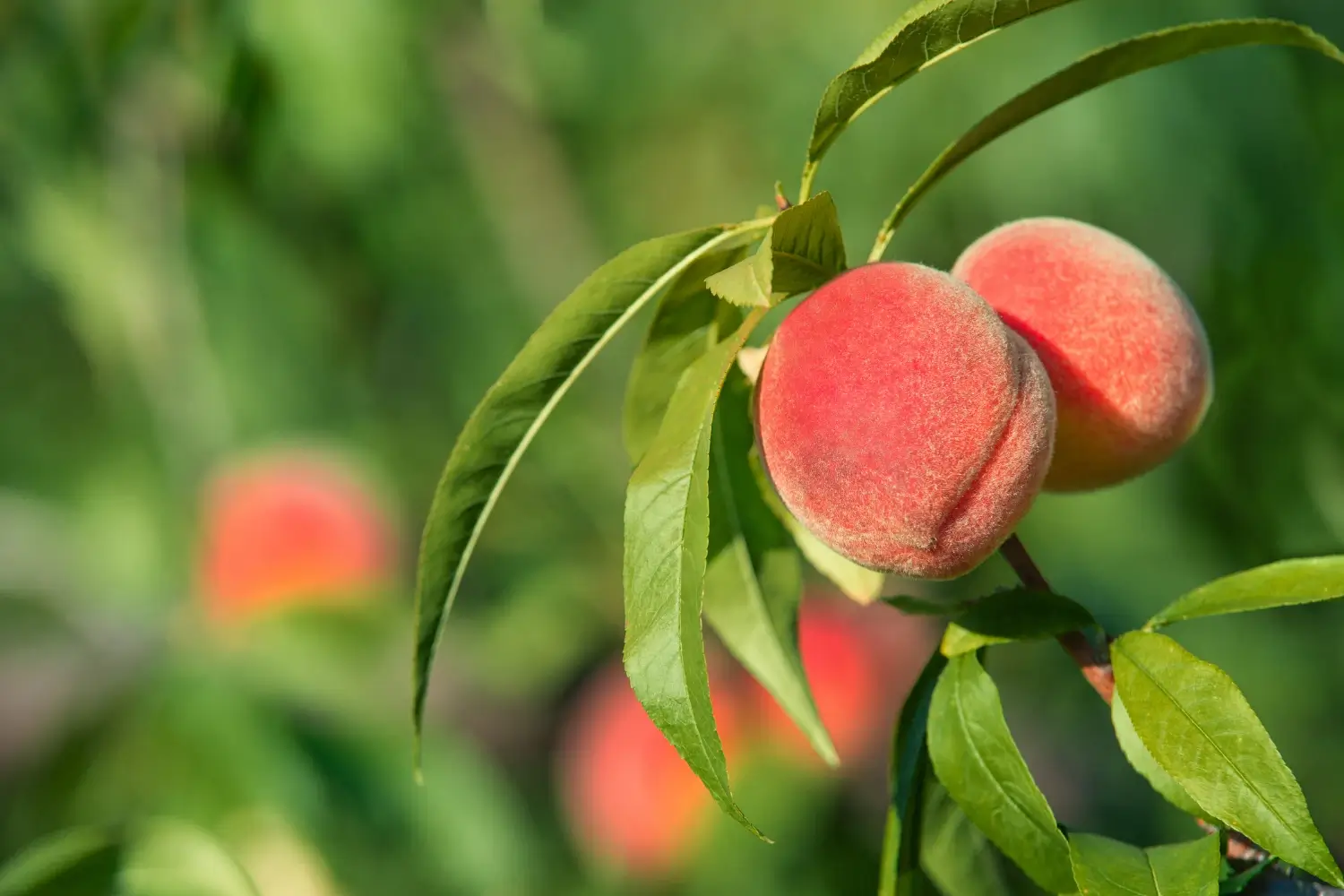
2. Which Peach Tree Will Produce The Biggest Fruits?
A study by Scorza et al. (1991) found that larger-fruited cultivars have more cells, not necessarily larger ones. This underscores the importance of selecting the right variety from the start.
Homeowner takeaway: Choose a variety known for large fruit genetics. This sets the foundation for success.
Here are several excellent varieties to consider:
- Majestic Peach: Known for its exceptional size and flavor, this cultivar consistently produces very large, juicy peaches. Great for fresh eating or desserts.
- Red Globe: Offers large, firm fruit with red skin and yellow flesh. Excellent for both fresh markets and processing.
- Dixieland: Large-sized peaches with soft, sweet flesh. Ideal for home gardeners looking for a dependable midseason harvest.
- Flamin’ Fury Jumbo: Bred for extreme fruit size and high quality. This series includes several selections, such as PF 24-007 and PF 25, which produce very large, attractive peaches suitable for Ontario’s climate.
- Redhaven: Not the largest variety, but an Ontario staple for its reliability and flavor. Consider combining it with larger-fruited varieties to extend your harvest window.
Pro tip: When selecting varieties for your home orchard, plant two or three with staggered ripening times to extend your harvest season and ensure fresh fruit from July through early September.
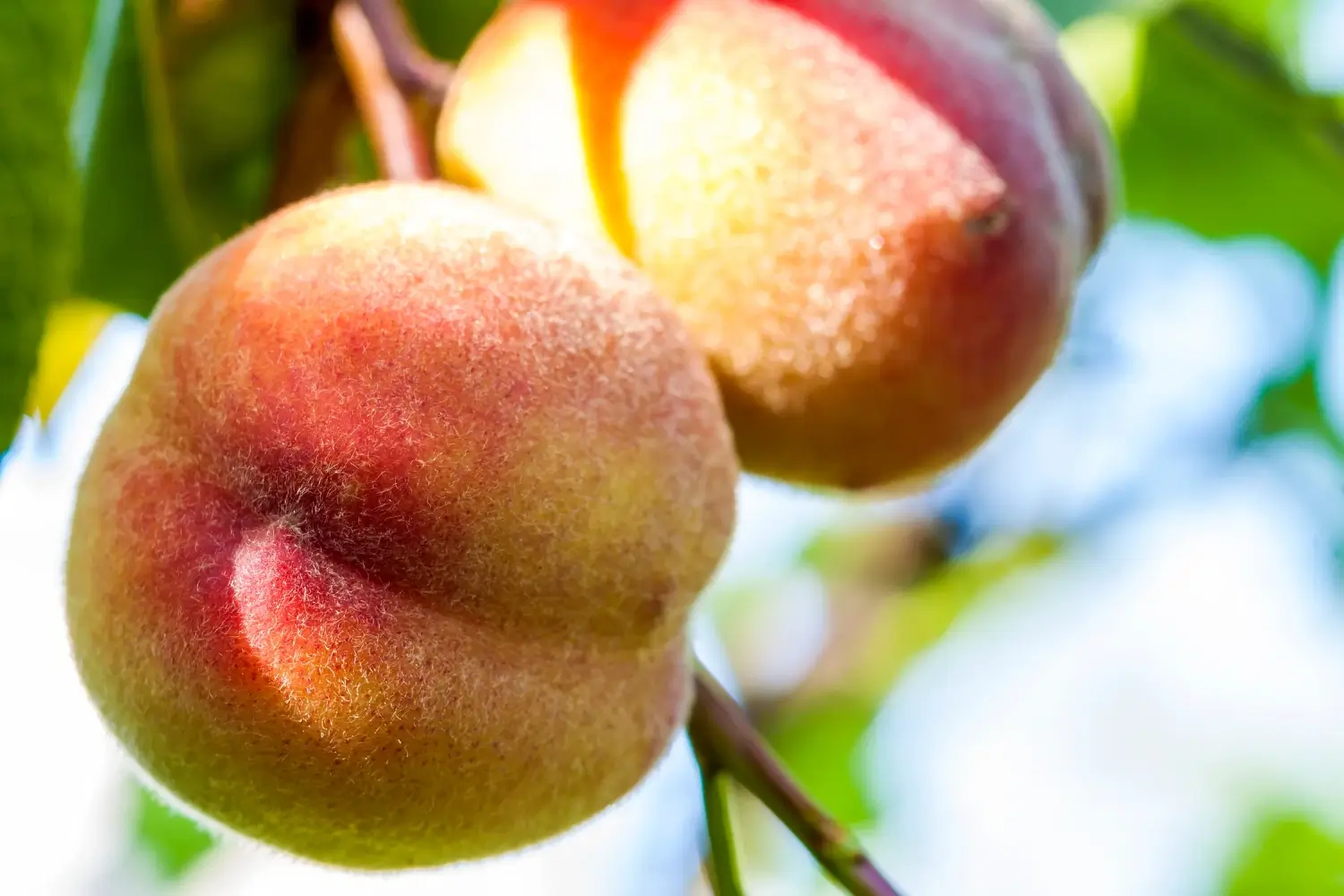
3. Watering Schedule & Recommendations For Larger Peaches
Water stress is one of the most critical limiting factors in achieving large, juicy peaches. During drought conditions or insufficient watering, trees close their stomachs, the microscopic pores in their leaves, to conserve moisture. Unfortunately, this also shuts down photosynthesis, reducing sugar production and stalling fruit growth.
Best irrigation practices for bigger peaches:
Avoid irrigation during Stage II (pit hardening): During this phase, the tree prioritizes shoot and leaf growth. Irrigation can cause excess vegetative growth and divert resources away from the fruit. Only irrigate if the tree shows visible signs of water stress, such as leaf curling or wilting.
Prioritize consistent irrigation during Stage III (final swell): This is when fruit rapidly expands. Water is essential for cell expansion and sugar transport. Inconsistent watering during this time can lead to smaller fruit and even physiological disorders like split pits or poor flavor.
Water volume guide:
- Mature peach trees require 30–40 gallons (110–150 litres) per day during hot, dry periods in Stage III
- Young trees require less water, but the root zone should still be kept evenly moist.
- Use drip irrigation or soaker hoses to apply water slowly and deeply, minimizing evaporation and runoff.
Scheduling tips:
- Water early in the morning to reduce evaporation.
- Avoid wetting the foliage to prevent disease pressure.
- In sandy soils, more frequent watering may be needed due to faster drainage.
Home gardener tip: Place a shallow basin around the base of your tree and mulch the soil with 3–4 inches of organic material (like wood chips or straw) to retain moisture and suppress weeds.
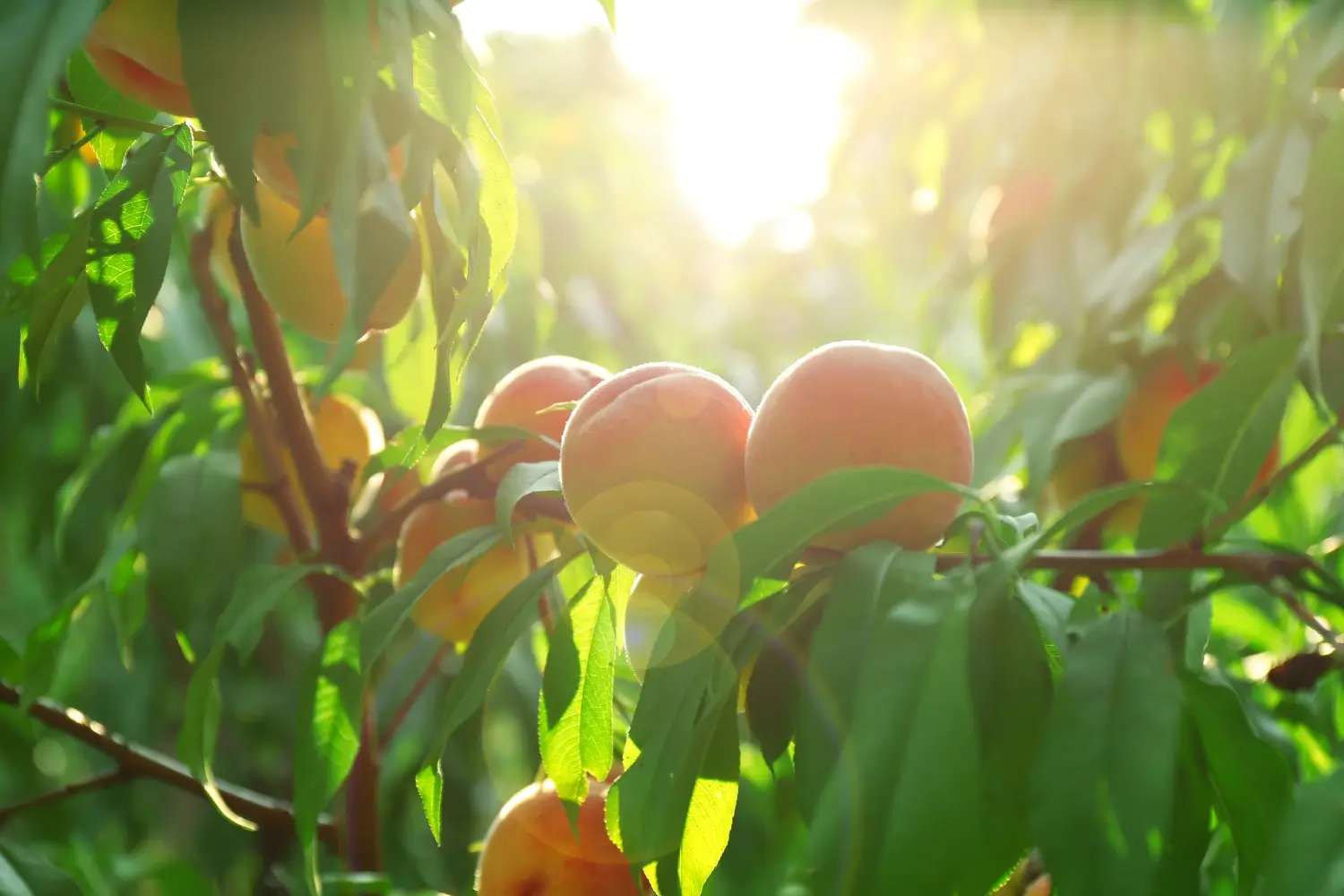
4. Pruning Techniques For Bigger Peaches
The biggest, most colourful peaches typically develop on the outer canopy and upper branches of the tree - areas exposed to the most direct sunlight. Without careful canopy management, interior fruit receives limited light, resulting in smaller, less sweet peaches.
Key canopy management practices:
Train trees to an open center (vase shape): This structure opens the center of the tree to sunlight and airflow. An open center form improves light distribution, reduces disease pressure, and enhances fruit color and size. Begin training at planting by cutting the tree back to 26–30 inches and removing side branches to form a “whip.”
Summer prune in June: Remove vigorous, upright water sprouts and interior shoots that shade fruiting wood. Aim to maintain a balanced framework of 3–5 main scaffold branches extending outward.
Maintain 20% or more full sunlight penetration in the canopy during Stage III: Light levels at this stage are directly tied to fruit sugar levels and final size. Use a light meter or conduct a visual assessment at midday. If the tree is too dense to let dappled light reach the interior, thin branches accordingly.
Use reflective mulch under the tree: White plastic mulch or aluminized reflective fabric placed under the canopy can bounce sunlight back into the tree’s interior, improving color and sweetness in otherwise shaded fruit.
Pro tip: Annual dormant pruning in late winter or early spring is essential to control tree size and remove dead or damaged wood. Always prune to an outward-facing bud to encourage spreading structure.
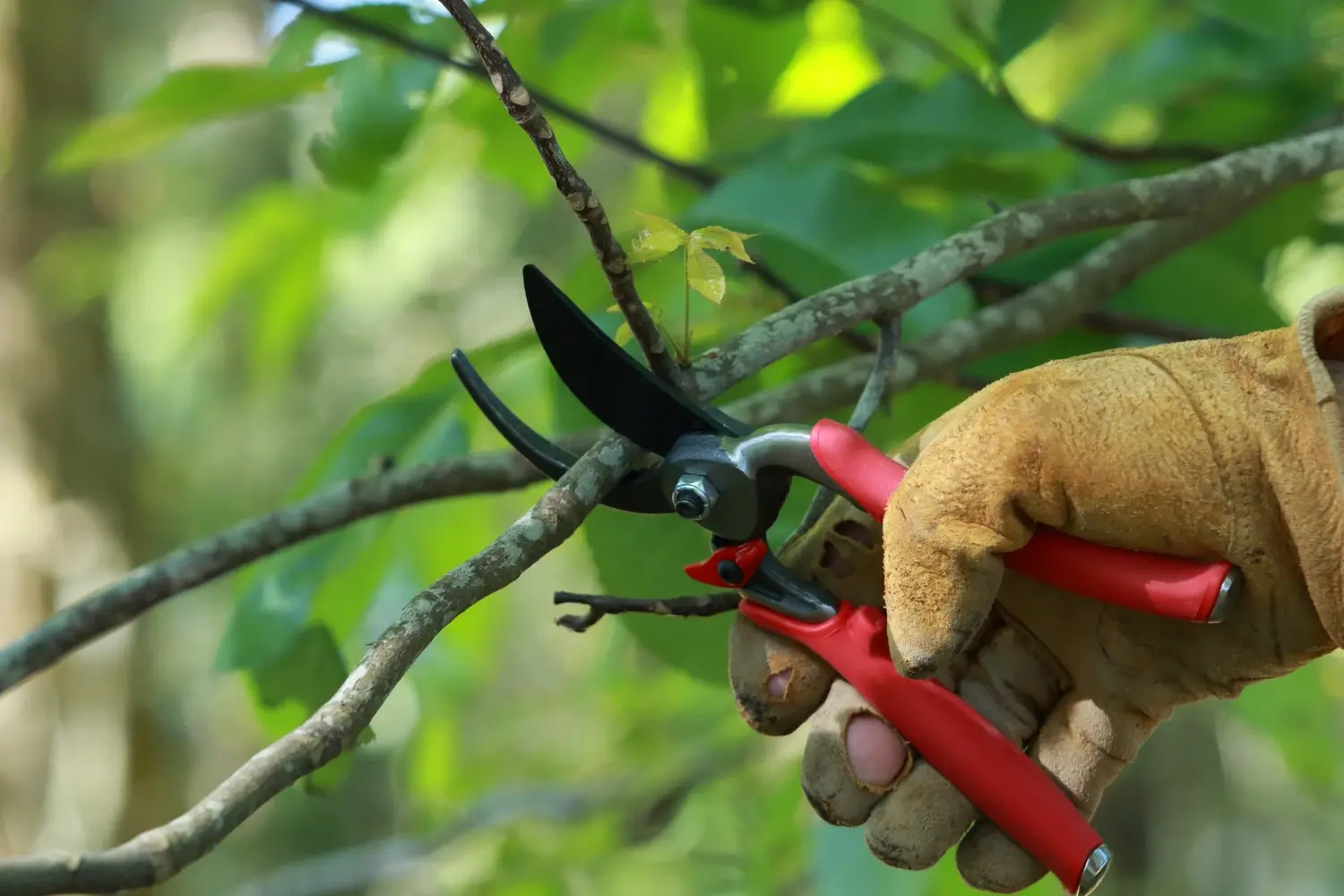
5. Thinning Your Peach Tree Is Essential For Larger Fruit
A peach tree often sets far more fruit than it can support. Without thinning, the tree’s energy is spread too thinly across dozens or hundreds of developing fruits, leading to smaller peaches with lower sugar content and poor color. Proper thinning is one of the most powerful tools you have to increase fruit size.
Best thinning practices:
- Timing: Thin fruit 3 to 4 weeks after bloom, or when fruit reaches nickel size (about 15–20 mm in diameter). Thinning earlier in Stage I helps maximize cell division, which directly impacts final fruit size.
- Spacing: Leave one fruit every 6 to 8 inches along each branch. Remove small, misshapen, or interior fruit, and retain the largest, healthiest ones in prime sun-exposed positions.
- Positioning matters: Keep fruit on the longest shoots, especially those with axillary leaves nearby. These leaves are vital sources of carbohydrates, and their proximity helps funnel more energy into the adjacent fruit.
- Techniques: Use hand thinning or padded pole shakers for high branches. Fruit can be gently twisted off the branch or pinched with pruners. Avoid damaging nearby buds or bark.
Homeowner tip: After thinning, the tree might look surprisingly bare, but don’t worry. The remaining fruit will be significantly larger, more colourful, and better tasting.
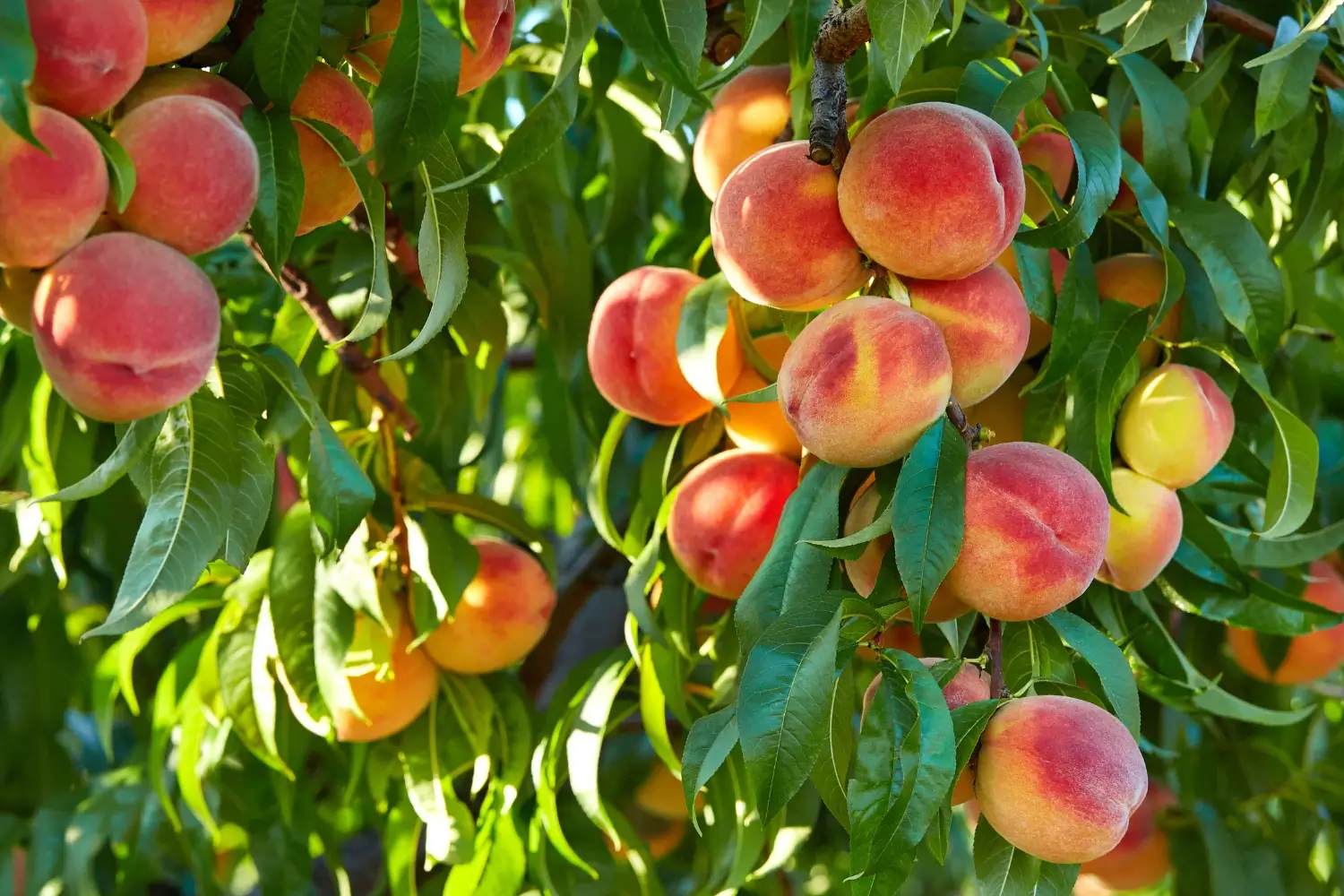
6. Recommended Peach Tree Fertilizer and Minerals
Proper nutrition is fundamental to maximizing peach size and quality. Trees must have access to all essential macro- and micronutrients in the right balance. Nutrient deficiencies - or even excesses - can reduce fruit size, impair growth, and increase disease susceptibility.
Key nutrients and targets:
- Nitrogen (N): Vital for vegetative growth and early fruit development. Aim for 2.8–3.4% leaf nitrogen during midsummer tissue analysis. Excessive nitrogen, however, may reduce fruit firmness and sugar levels.
- Potassium (K): Essential for fruit swelling and sugar transport. Target 1.0–1.5% leaf potassium. Potassium deficiencies can lead to small, soft fruit and poor color.
- Phosphorus (P): Important for root development and early-season growth. Maintain around 0.3–0.5% leaf phosphorus.
- Calcium (Ca): Crucial for cell wall strength. Low calcium can lead to fruit breakdown or poor shelf life. Maintain 1.0–1.5% leaf calcium.
- Magnesium, Iron, Zinc, and Boron: Also essential in smaller amounts. Monitor with annual or biennial leaf and soil testing.
Best practices:
- Test the soil before planting and every 3–4 years to correct any pH or baseline fertility issues. Peach trees prefer a soil pH of 6.0 to 6.5.
- Leaf analysis in midsummer (July) offers the best indicator of nutrient uptake and tree status.
Split fertilizer applications:
- Apply half your fertilizer dose in early spring, before bloom
- Apply the second half at shuck split (when the last of the flower shucks fall off) if fruit is developing
Avoid late-season nitrogen applications, which can stimulate vegetative growth and delay dormancy, increasing the risk of winter injury.
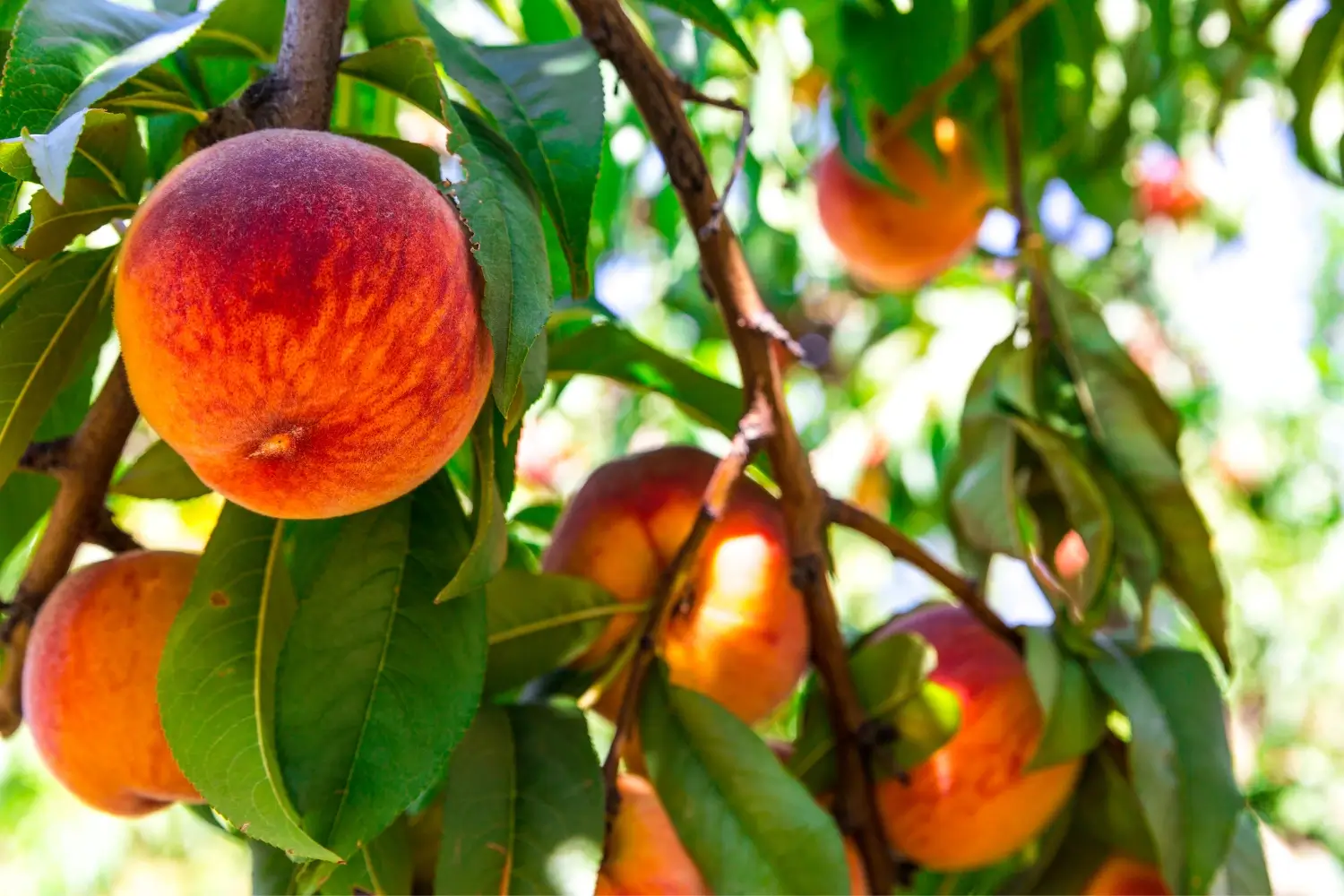
7. How To Plant Your Peach Trees To Encourage Growth
When it comes to planting peach trees at home, you don’t need to manage acres like a commercial orchard, but understanding tree spacing and how you train your trees can make a big difference in fruit size and ease of care.
Recommended planting systems for home gardens:
1. Open Center (Vase Shape)
This is the most popular system for backyard peach trees. It encourages an open canopy that lets sunlight reach all parts of the tree, promoting larger, sweeter fruit. Trees are spaced widely, typically 15 to 20 feet apart, to allow room for growth and airflow.
2. Modified Central Leader
This system keeps a strong central trunk with well-spaced side branches, which can help simplify pruning and harvesting in smaller spaces. Trees are spaced around 12 to 15 feet apart.
Unlike commercial orchards that often replace trees every 10–15 years, a well-cared-for peach tree in your backyard can thrive and produce quality fruit for 15 to 25 years or more.
Practical tips for homeowners:
- Choose a planting location with at least 6 hours of direct sunlight daily.
- Space trees at least 15 feet apart to encourage healthy growth and airflow.
- Use mulch to retain soil moisture and reduce weeds around your tree.
- Avoid planting more than 2-3 peach trees close together unless your garden space is very large.
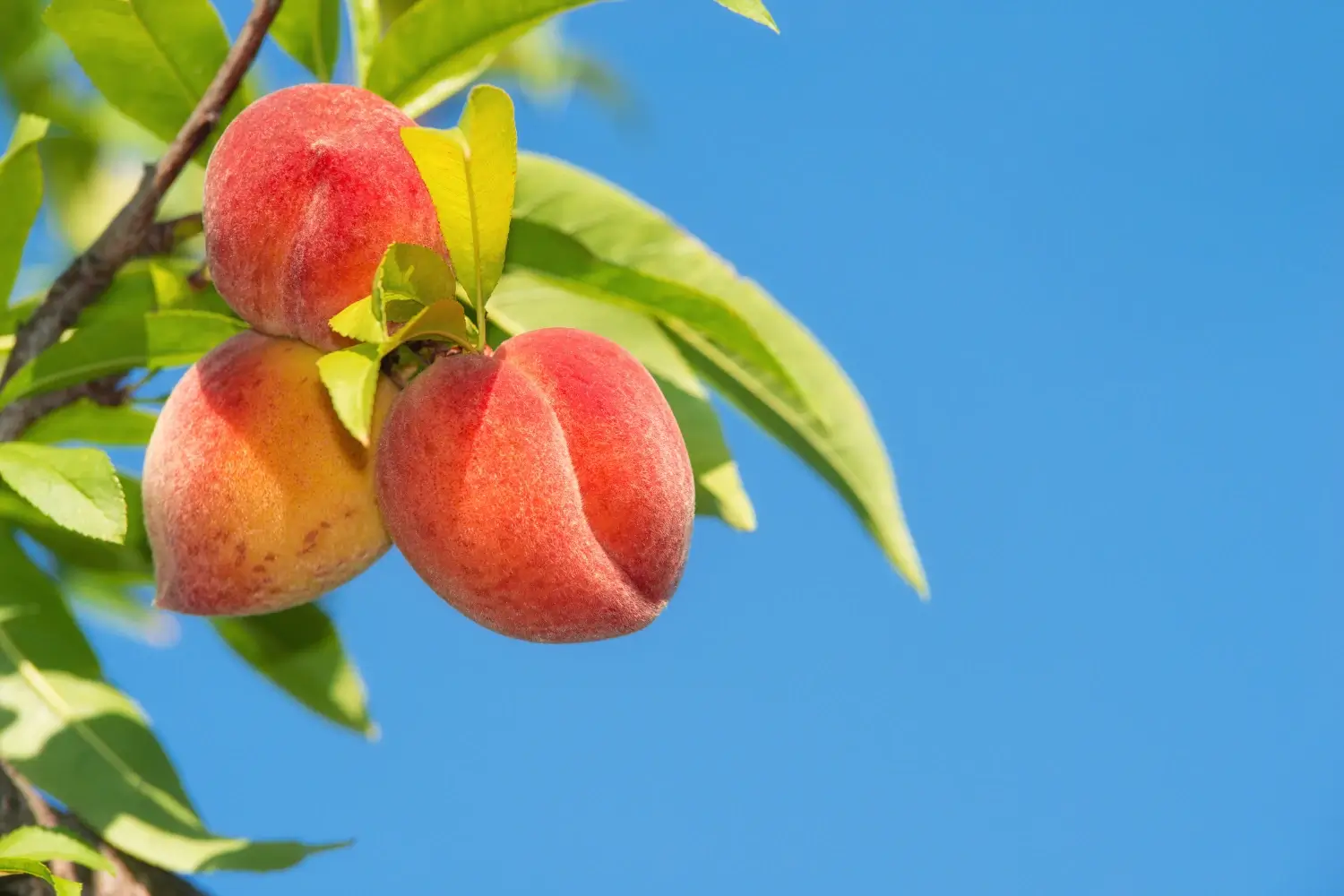
8. Best Peach Trees for Ontario
Growing peaches successfully in Ontario means choosing cultivars that can handle our sometimes harsh winters and fluctuating spring temperatures. Winter bud hardiness - the ability of the tree’s flower buds to survive cold snaps - is key to a reliable harvest year after year. Selecting the right cultivar also affects fruit size, flavour, and harvest timing, helping you enjoy fresh peaches throughout the season.
Top Peach Cultivars Recommended for Ontario Home Gardens:
Redhaven
The most widely planted peach in Ontario and a staple in many home orchards. Redhaven is a midseason variety, typically ripening in late July to early August. It’s known for its cold hardiness, reliable yields, and classic sweet flavor with firm, medium-large fruit.
Harrow Diamond
Developed in Ontario, Harrow Diamond is an early-season cultivar that ripens in July. Producing medium to large peaches that are firm, sweet and juicy. This type of peach tree is resistant to common diseases, requiring minimal maintenance.
Vivid
Another Ontario-bred cultivar, Vivid is known for large fruit size and vibrant red skin. It ripens in midseason and produces flavorful peaches with the perfect balance of sweetness and acidity. Vivid also offers good winter hardiness and disease resistance.
Glohaven
This cultivar offers very large fruit with excellent sweetness and firmness. Glohaven ripens in mid to late season (August), extending the peach harvest window for home growers who want fresh fruit into late summer. It is well-adapted to Ontario’s climate with solid cold hardiness.
Harrow Beauty
A late-season peach, Harrow Beauty is loved for its exceptional fruit color and large peaches (often exceeding 200g). Ripening in August to early September, it’s perfect for extending your backyard peach season into the fall. The fruit has a rich flavor and good firmness, suitable for fresh eating and desserts.
Additional considerations for Ontario gardeners:
- Plant multiple cultivars with staggered harvests. Combining early, mid, and late-season varieties ensures a continuous supply of fresh peaches from July through September.
- Ensure winter bud protection by planting trees in slightly elevated areas with good air drainage, and consider frost protection measures in early spring.
- Look for disease-resistant cultivars if you prefer less chemical intervention. Ontario-bred varieties generally have improved resistance to common peach diseases like bacterial spot and peach leaf curl.
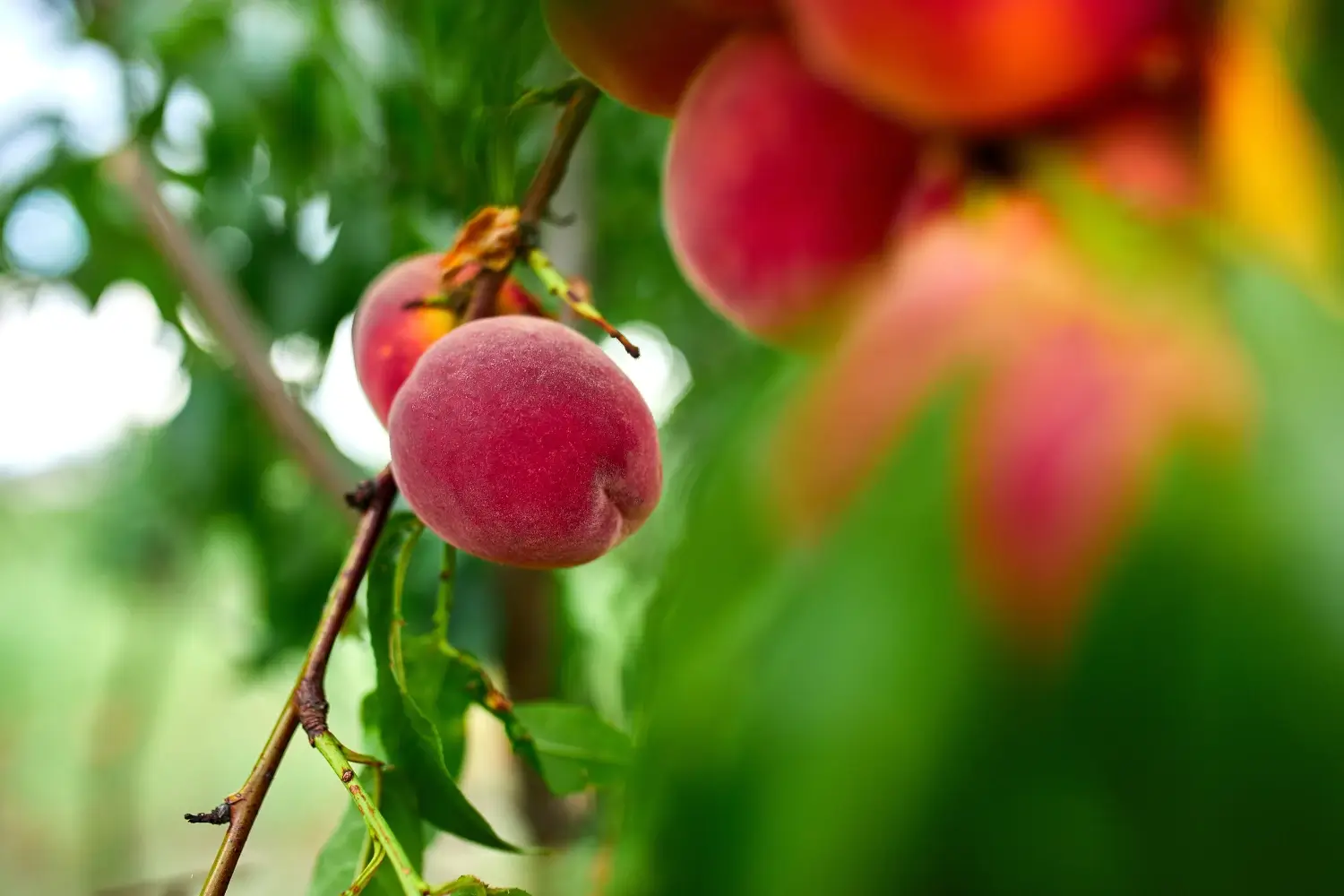
10. Peach & Nectarine Growing at Home: Mini Guide
Growing peaches and nectarines in your own yard can be incredibly rewarding. Whether you want a single majestic tree as a garden focal point or a small mini orchard to supply your family with fresh fruit, success starts with good planning and consistent care. Here’s what every homeowner should know to get the biggest, sweetest peaches possible.
1. Site Selection
- Full Sunlight: Peach trees are sun lovers. Aim for at least 6 to 8 hours of direct sunlight daily. Sunlight drives photosynthesis, crucial for sugar production and fruit development.
- Well-Drained Soil: Peaches dislike “wet feet.” Select a planting site with well-drained sandy loam or loamy soil to prevent root rot and other moisture-related issues.
- Elevated Location: If possible, plant on a slight rise or slope. Cold air sinks at night, so higher ground reduces the risk of frost damage to tender buds and blossoms during late spring.
- Avoid Shade: Don’t plant near large trees, buildings, or fences that could cast shadows during critical growth periods.
2. Planting and Maintenance
- Tree Selection: Choose 1-year-old bare-root trees about 3 to 4 feet tall. Bare-root stock establishes quickly and is easier to plant.
3. Spacing:
- For home gardens with open center training, space trees 12 to 16 feet apart to allow good airflow and sunlight penetration.
- If you’re planting fewer trees and want larger fruit, lean toward wider spacing (18 to 20 feet).
4. Training and Pruning:
- Train your trees to the classic open center (vase) shape for optimal light exposure.
- Prune annually to remove crowded or crossing branches, maintain a 3- to 5-main scaffold structure, and open the canopy. This improves fruit size, reduces disease risk, and makes harvest easier.
5. Watering
Especially important in the first 3 years and during the critical Stage III fruit swell (last 4-6 weeks before harvest). Use drip irrigation or soaker hoses for consistent moisture, avoiding wetting foliage.
6. Fertilizing Schedule
- Year 1: Apply about 1 lb of balanced 10-10-10 fertilizer, split into two applications - once early spring and once 40 days after planting.
- Years 2–3: Increase to 1.5 lbs per tree, again split between early spring and early summer.
- Mature Trees: Apply 1 to 2 lbs annually, depending on tree size, vigor, and crop load. Spread fertilizer evenly around the drip line (the outer edge of the canopy), keeping it away from the trunk.
7. Thinning
- Timing: Thin fruit about 3–4 weeks after bloom or when peaches are roughly the size of a nickel.
- Spacing: Aim for 6 to 8 inches between fruit on each branch to minimize competition and promote larger individual fruit size.
- Selection: Remove smaller, misshapen, or clustered fruit, and prioritize peaches in sun-exposed positions on longer shoots with axillary leaves for optimal carbohydrate supply.
8. Pest and Disease Management
- Common Pests: Watch for plum curculio, oriental fruit moth, and peach tree borer. Handpick or use traps as needed.
- Good Sanitation: Keep the area around your tree free of fallen leaves, mummified fruit, and other debris to reduce overwintering pests and diseases.
- Dormant Sprays: Applying appropriate dormant oils or fungicides before bud break helps control overwintering insects and fungal spores.
Diseases to Monitor:
- Peach leaf curl: Manifests as reddish, puckered leaves in spring. Prevent with dormant copper or lime sulfur sprays.
- Brown rot: Fungal disease affecting fruit near harvest; manage by pruning for good airflow and applying fungicides if necessary.
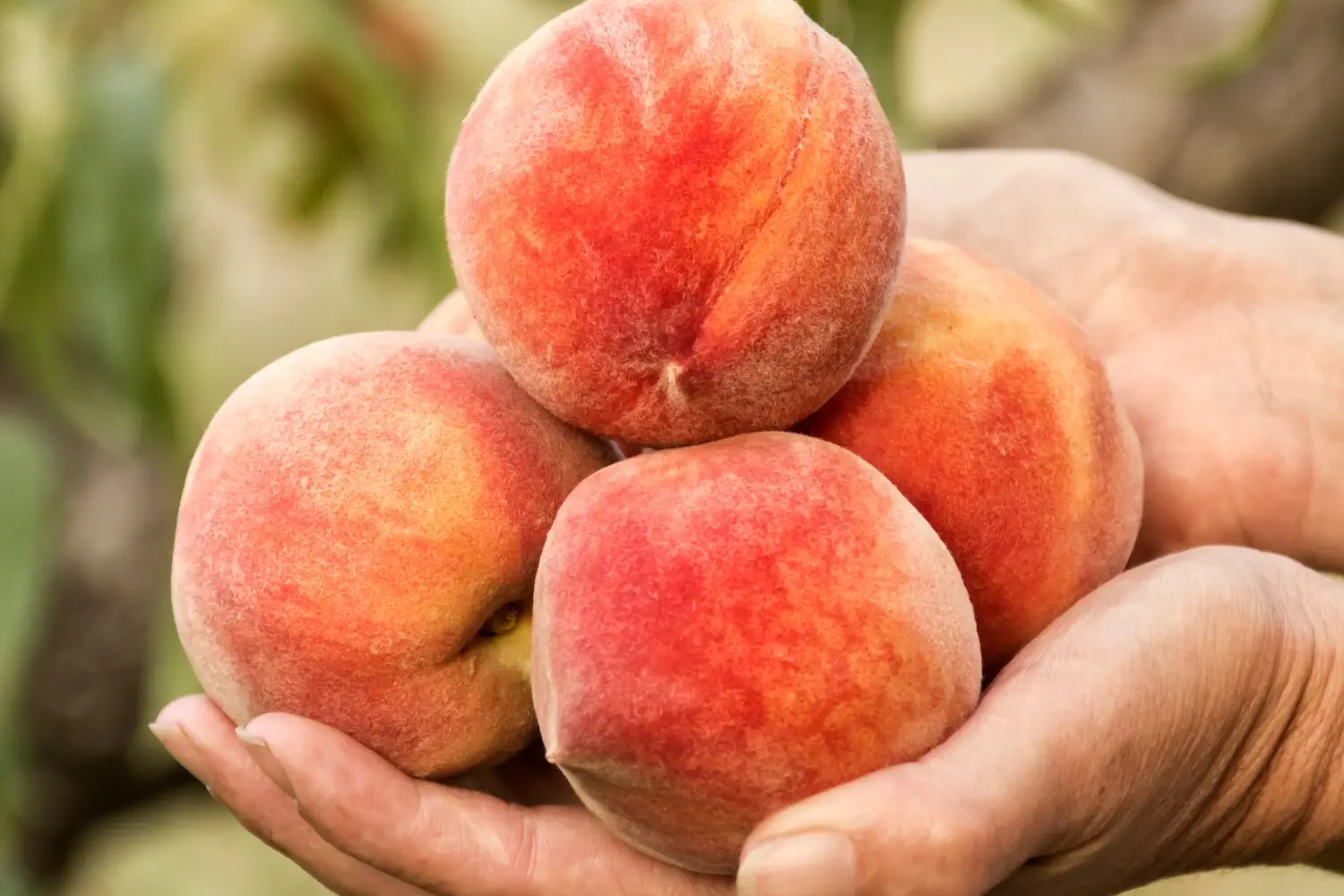
Growing large, beautiful peaches isn’t just about luck - it’s a blend of smart genetics, precise timing, and intentional landscape design. At Action Home Services, we help Toronto-area homeowners create gardens that are as productive as they are luxurious. Whether you're starting fresh with new trees or revitalizing an existing orchard, we’d love to help you integrate fruit trees into your dream outdoor space.
Ready to transform your backyard into a personal orchard? Contact Action Home Services to bring expert horticulture, design, and craftsmanship to your landscape.


